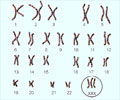Scientists at the University of Warwick have discovered the switch that pulls together X chromosomes in female cells at a crucial stage of embryo development.
The discovery could offer new insights into how other similar chromosomes spontaneously recognize each other and are bound together at key parts of analogous cell processes.The discovery holds importance as the binding together of too many or too few of a particular chromosome can cause a number of medical conditions such as Down's Syndrome or Turner's Syndrome.
During embryo development, in a step necessary to survival, one of the X chromosomes is silenced in each female cell to ensure that the levels of X-derived products are equalized in XX females and XY males, via a process known as X-Chromosome Inactivation (XCI).
Physicist Dr Mario Nicodemi, has recently detailed how one X chromosome is able to silence another as part of the XCI process. However for that stage in the process to happen the X chromosomes have to quickly pair off, via process called colocalization, in a way that allows each part of those pairs of X chromosomes to be very close together and aligned in a particular way.
Chromosome colocalization events are common in cells, and one such event is meiosis: for sexual reproduction to succeed in producing viable cells all of the homologous chromosomes in the process have to, almost simultaneously, bind together in pairs.
However, till date, researchers have had no clear understanding of how the X chromosomes actually suddenly pair off so quickly and consistently allowing this to happen.
Advertisement
In the latest study, researchers have looked at a particular "DNA specific binding molecule" including a protein known as CTCF that seemed to play a role in pairing off of X chromosomes.
Advertisement
For the study, the researchers created a model of the interaction between X chromosomes and CTCF proteins using polymer physics. They looked at models of chains of polymer beads that had almost the same number of chemical binding sites on their beads as the number of known CTCF binding sites in the key part of X chromosomes.
And it was found that a key tipping point was reached if the amount of CTCF present in the system reached a critical threshold - a concentration of around 0.1 mg per millilitre or less, below which very little happened.
Random bindings did occur but not often enough or quickly enough to build the sort of momentum necessary to produce the total and sudden of X Chromosomes colocalization required for successful X inactivation.
But, once the threshold concentration is reached it produces a tipping point or thermodynamic switch.
That particular concentration of CTCF was suddenly enough to ensure that the CTCF proteins could encounter and bind in quick succession to two X chromosomes forming a chemical bridge between them and almost instantly bringing about colocalization of the X chromosomes and making embryo development successful.
According to researchers, the newly discovered "thermodynamic switch" not only explains how X chromosomes pair up during meiosis but also apply to a range of other cell processes that involve the recognition and pairing of DNA sequences including other homologous chromosomes.
This is of particular importance, e.g., at meiosis, as the binding of togetgher of too many or too few of a particular chromosome can cause a number of medical conditions.
The findings were published in PLOS in a paper entitled Mechanics and Dynamics of X-Chromosome Pairing at X Inactivation.
Source-ANI
SRM












